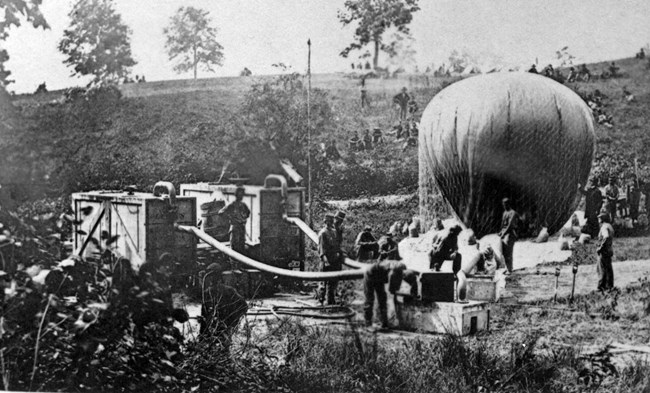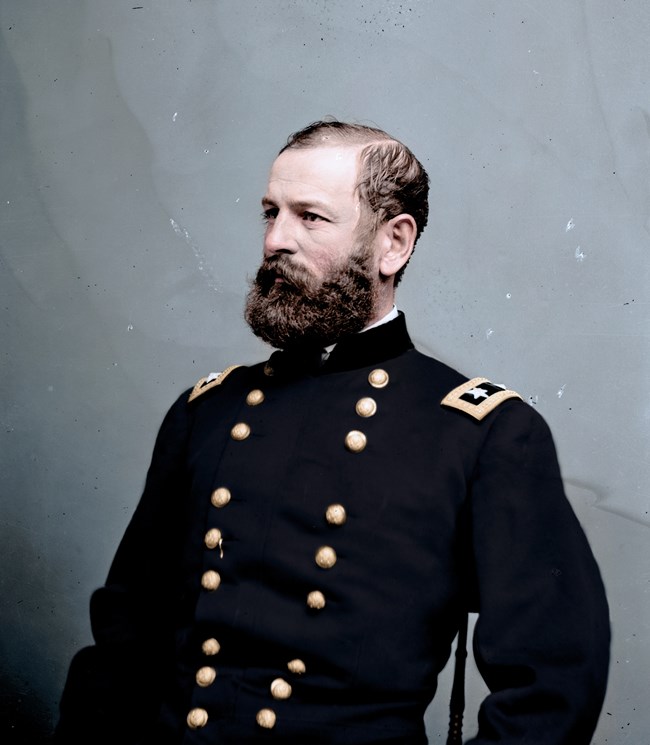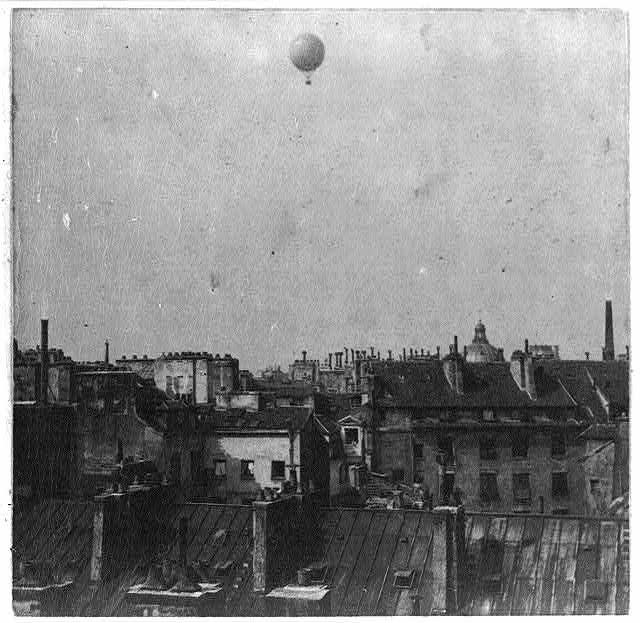Last updated: January 12, 2021
Article
Air Balloons in the Civil War

Library of Congress
Civil War balloons like the Intrepid and Union (Union) and the Gazelle (Confederate) were used for reconnaissance or directing artillery fire on enemy positions. They could reach elevations of 1,000 feet, allowing a great vantage for miles around. Operators would use signal flags or telegraphs to send information to soldiers on the ground. The Union’s balloon program was most successful under the leadership of Thaddeus Lowe. Professor Lowe earned the trust of President Lincoln, to whom he described via telegraph the view of Washington D.C from a balloon in the summer of 1861. Shortly thereafter Lowe was named chief aeronaut of the newly created Balloon Corps.

Mathew Brady
While balloons used in the Civil War were usually safely tethered to the ground, sometimes mishaps occurred. During the Peninsula Campaign, Union General Fitz John Porter had an unnerving experience in a balloon. Porter was one of General George B. McClellan’s closest generals. He was also interested in balloon technology and had the experience of ascending with Lowe. On April 11, 1862, during the siege of Yorktown, Virginia, Porter decided to do his own reconnaissance and ascended in a balloon.

Library of Congress

Library of Congress
Ulysses S. Grant's Connections to Balloons
General Ulysses S. Grant’s experiences with balloons during the Civil War were minimal if any. While he certainly heard about their exploits in the East, they were not used in the battles he fought in the West, and the Balloon Corps was already disbanded by the time he assumed command of all the Union armies. There are only two vague accounts of General Grant dealing with balloons during the Civil War. The first was a telegraph sent to him by General Benjamin F. Butler on October 13, 1864, during the siege of Petersburg. The telegraph read, “the enemy have reinforced in front of my old line now commanded by Col. Potter who thinks they may attack him-I do not-They have been reconnoitering this evening [with] a balloon.” The second account concerned a Frenchman, Eugene Godard with the “Aeronaute de I’ Empereur.” On February 21, 1865, Mr. Godard wrote to Grant, “offering his services as a balloon ins[tructor]. Then on March 3, 1865, Lt. Colonel Adam Badeau of Grant’s staff wrote Godard “declining the offer.” Perhaps the end of the war in sight influenced this decision not to use his services.Grant’s only documented personal experience with a balloon comes from a reporter named John W. Forney. He recounted that Grant visited a balloon, The Captive on October 10, 1878, in Paris, France during his world tour. Although Grant was escorted around the grounds “he did not ascend but was curious about the whole organization.” Forney went on to say about the event, “The projector, Gifford, left offended because the ex-president did not gush, I was a little sorry, but then Grant is not very effusive even to Frenchmen.”
American Battlefield Trust. “Civil War ballooning.”Civil War Ballooning | American Battlefield Trust (battlefields.org)
American Battlefield Trust. Balloons in the Civil War.Balloons in the Civil War | American Battlefield Trust (battlefields.org)
Papers of Ulysses S. Grant. John Y. Simon ed. Southern Illinois University Press.Volume 12 p. 308. Volume 14 p. 447 and Volume 29 p. 10.
The War of the Aeronauts pp. 181-183. “Unplanned Flight of General Fitz John Porter: April 11, 1862.Professor Thaddaeus Lowe.Thaddeus Lowe at Yorktown
American Battlefield Trust. Balloons in the Civil War.Balloons in the Civil War | American Battlefield Trust (battlefields.org)
Papers of Ulysses S. Grant. John Y. Simon ed. Southern Illinois University Press.Volume 12 p. 308. Volume 14 p. 447 and Volume 29 p. 10.
The War of the Aeronauts pp. 181-183. “Unplanned Flight of General Fitz John Porter: April 11, 1862.Professor Thaddaeus Lowe.Thaddeus Lowe at Yorktown
